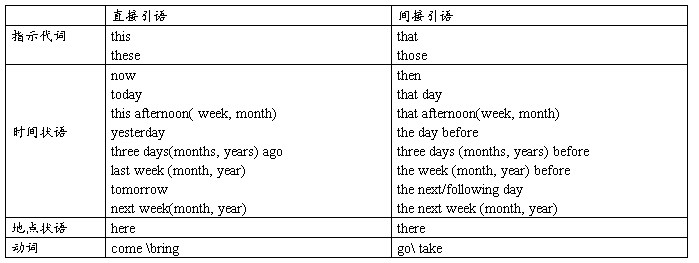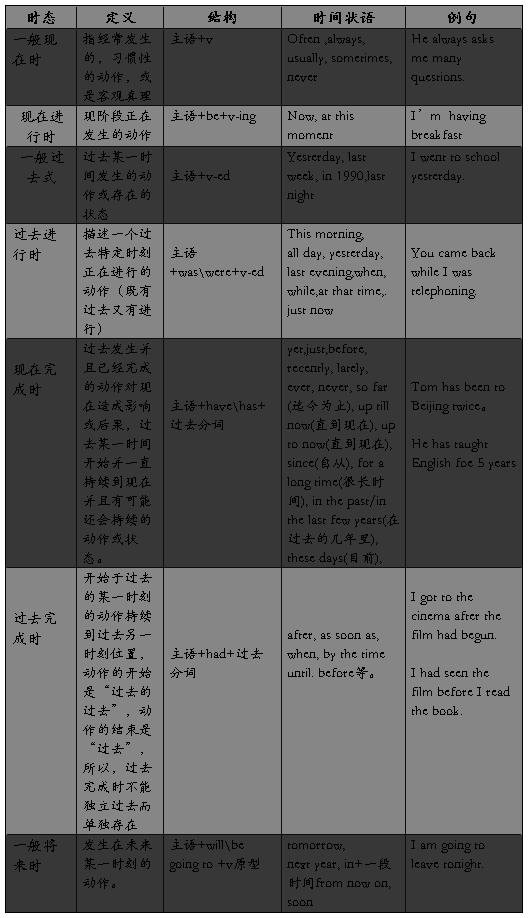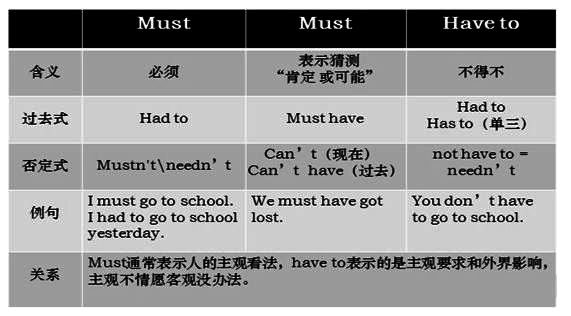直接引语和间接引语
一、概念
直接引语是直接引述别人的话。前后要加引号。
间接引语是用自己的话转述别人的话。多数情况下构成宾语从句,且不用引号。
She says, “I’ll never forget the moment.” 她说:“我将永远不会忘记此刻。”(直接引语)
She says that she’ll never forget the moment. 她说她将永远不会忘记此刻。(间接引语)
二、直接引语如何变为间接引语
直接引语变为间接引语时,多数情况下构成宾语从句或复合宾语。
(一) 句式的变化
1. 直接引语如果是陈述句,变为间接引语时,要变为用连词that引导的宾语从句(that在口语中常省略)
He said, “I want to be an actor.”
→ He said (that) he wanted to be an actor.
The doctor said, “You should drink plenty of water.”
→The doctor told me that I should drink plenty of water.
2. 直接引语如果是疑问句,变为间接引语时,要改为陈述句语序(主语在谓语前)
1) 直接引语如果是一般疑问句或反义疑问句,变为间接引语时,要变为whether或if引导的宾语从句。
“Can you swim?” he asked me.
→ He asked me if/ whether I could swim.
He said to me, “You are interested in computer games, aren’t you? ”
→ He asked me if/whether I was interested in computer games.
2) 直接引语如果是特殊疑问句,变为间接引语时,连接词要用直接引语中的疑问词。
“What can I do for you?” he asked me.
→He asked me what he could do for me.
3. 直接引语如果是祈使句,通常变成tell/ ask/ order sb. (not) to do sth. 的结构。
“Please open the window,” the teacher said to me.
→ The teacher asked me to open the window.
(二) 人称的变化
把直接引语变为间接引语时,要根据意思改变人称。通常遵循“一随主,二随宾,三不变”的原则。
“一主”是指直接引语中的第一人称代词在间接引语中应与引述部分主句的主语一致的人称一致。
“二宾”是指直接引语中的第二人称代词在间接引语中应与引述部分的宾语人称一致。
“三不变”是指直接引语中的第三人称在间接引语中保持不变。
例:
He said, “I like it very much.” → He said that he liked it very much.
“Can you sing in English?” he asked me.→ He asked me ifI could sing in English.
He said, “Shewill come late.” → He said that shewould come late.
She said, “I’m full.” →She said that she was full
(三) 时态的变化
主句为现在或将来时态,间接引语的时态一般不变;主句为过去时态时,间接引语一般作相应的变化。变化见下表:

但凡事都有例外,下列情况直接引语变为间接引语,其时态不变:
1. 当直接引语表示客观事实或普遍真理时,变为间接引语,时态不变。
The teacher said, “The earth goes round the sun.” → The teacher said that the earth goes round the sun.
2. 当直接引语中有具体的一般过去时间作状语时,变为间接引语时,时态不变。
She said, “I was born in 1990.” → She said that she was born in 1990.
(四) 指示代词、时间状语、地点状语和动词的变化
直接引语变间接引语时,指示代词、时间状语、地点状语和某些动词通常要作相 应的变化。变化如下表:

e.g. He said, “I’m listening to music now” àHe said that hewas listening to music then
1. (2009·陕西) —Can you tell me _____ your parents at home? —I often wash clothes and sweep the floor. A. how will you help B. how you help C. how you will help D. how do you help
2. (2009·广东)Our teacher told us the sun _____in the east. A. rise B. rose C. rising D. rises
3.“When will you leave Athens?” Peter asked me. à ______________________________________.
第二篇:新概念二上半册知识点总结
新概念二 上半册知识点总结
一. 短语

二. Grammar
1.时态

2.可数名词和不可数名词
可数名词是指:能用数字计算的事物名称,如,one house,two houses;
不可数名词是指:不能用数字计算的名称的词,如beer,cheese。英语不说a beer , a cheese .英语中不可数名词都没有复数。若想在不可数名词前加表达数量的词则“量词+of”如: a glass of water, a piece of cheese.常见不可数名词: milk, beer, water, honey, cheese, paper, butter, chicken, beef, medicine等
3.比较级与最高级:
形容词和副词的比较级只限于两者之间,三者或者三者以上必须用最高级。
形容词副词变化规律:
1.直接在词尾加er\est 如:great-greater-greatest
2. 以e结尾的加r\st 如:free-freer-freest
3.以辅音+y结尾的,变y为i+er\est 如:happy-happier-happiest
4.辅音结尾的重读闭音节,双写福音字母+er\est
5.三个火三个以上的 多音节词 加more或most
6.不规则变化:
Many-more-most
Little-less-lest
Good-better-best
比较级:A +be +形容词比较级+than +B
Eg:她比她姐姐高 she is taller than her sister.
最高级:A+be+the+形容词最高级+比较范围
Eg:她是他们班里最高的。She is the tallest in their class.
原级比较:as·····as
Eg: 她和他姐姐一样高
She is as tall as her sister
4.表示时间的介词:at,in,on,by
At:具体的某一时间点,如:at 8:30,at midnight在午夜在某个节日或一年中的大日子表示较短暂的一段时间at New Year, at Christmas.
In:后接年,季度,月份 in 1998,in summer,in May
On:具体的某一天,on Sunday.在特定的某个早上,下午,晚上。 On the night of 6th.
By:不迟于,在某时前 如: by 5 o’clock五点前 在···期间,在···的时候 如:by day 白天,by night 晚上
5. 被动语态:
语态是动词的一种形式,用来说明主语与谓语动词之间的关系。英语的语态共有两种:主动语态和被动语态。主动语态表示主语是动作的执行者,被动语态表示主语是动作的承受者。汉语往往用"被"、"受"、"给"等词来表示被动意义。
结构:be+过去分词
一般现在时: is/am/are done
一般过去时: was/were done
现在进行时: is/am/are being done
现在完成时: have/has been done
过去完成时: had been done
一般将来时: will be done
过去进行时: was/were being done
情态动词: can be done, must be done, could be done, may be done, might be done,
6.直接引语和间接引语:
定义:一字不改的引述别人的话叫直接引语。
用说话人自己的话专属别人的话叫间接引语。
1.直接引语为陈述句:用that引导,that后用陈述句语序。
The teacher said:”you must bring your book to me”
The teacher said that I must bring my book to her.
2.直接引语为疑问句:用whether,if引导
He said :” are you will leave tomorrow?”
He asked us whether I will leave tomorrow.
3.直接引玉为特殊疑问句:用原特殊疑问词引导
“who will help me”? He asked.
He asked who would help him.
7.条件句:
条件句是表示某种条件下,预期会产生某种结果的表达方法。
1.从句用现在时,主句用将来时。
Eg:如果你现在走,你就会及时到达
If you leave now, you will arrive in time.
Eg:如果你现在努力学习你将来就会有钱。
If you study hard now, you will be rich.
Eg:如果他不忙,他就会来。
If he is not busy, he will come.
2.还可以用于表示命令或劝告,主句用现在时,从句用祈使句
Eg:如果你出错了,改正它.
If you make a mistake, correct it.
8.must和have to:

9.Have 的用法:
1.作为助动词,帮助完成各种时态。
2.“有”一般不用于进行时,疑问句及否定式构成方式多用助动词do,
否定式为haven't 和hasn’t:
Do you have money? I haven't any money.
3.和许多名词一起用表示一种活动或动作:
Have a holiday 度假
Have dinner 吃饭
Have a bath 洗澡
Have a smoke 吸烟
10.May 和 can:
1.may(might)和can(could)都表示请求许可,委婉度排名为can-could -may-might
Can I look at your book?
Could I look at your book?
May I look at your book?
Might I look at your book?
2.May 和might 也用来表示猜测,might 可能性比may小,
过去式为may\might +have +done
I may call you tomorrow.(不肯定)
I might call you tomorrow.(更不肯定)
You may have seen us before. (不肯定)
You might have seen us before..(更不肯定)
11.动名词:
动名词由动词+ing构成,动名词可做句子中的不同成分。

1.做主语:seeing is believing 眼见为实
2.做宾语:she is interested in dancing.
3.做表语:the main thing is getting there in time.
动名词做表语形式与进行时相同,但所属结构不同
如:His job was washing.他的工作是洗衣服
She was washing.她正在洗衣服。
